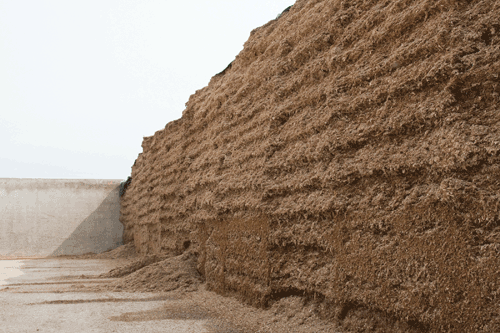The goal of silage face management is to minimize exposure to oxygen. In the presence of oxygen, yeast can metabolize lactic acid (a strong acid that keeps the silage pH low). When pH rises, undesirable fungi and bacteria are able to grow and further spoil the silage. This spoilage is translated into dry matter (DM) losses that can be as high as 10 percent when face management is marginal. Good face management practices are necessary to minimize DM losses.
Style varies
Bunker face techniques are highly variable from farm to farm. We randomly selected three dairies from our sample population in California. Each one faced differently - with a wide range of quality results.
Dairy 1: Silage face practices are poor. The front loader lifts the silage from the bottom of the pile to the top, allowing oxygen to enter the face.
Dairy 2: The silage face is smooth and perpendicular to the floor. The face is carefully shaved across the width (from side to side).
Dairy 3: The dairy uses a face shaver. It is estimated that face shavers can reduce DM losses by 3 percent compared to front-end loaders. However, more research needs to be conducted.
Fundamental practices
Adequate face management results from adhering to a few key practices.
Maintain a smooth surface. The feedout face should be a smooth surface (with no cracks) and perpendicular to the floor. The advantages of a smooth and perpendicular face are reductions in:
A desirable removal rate can only be achieved if the silage pile is sized according to the herd needs. If the pile's face is oversized, it is recommended to work on removing small sections of the silage face at a time. Silage removal rate in California varied with herd size.
Minimize the time loose silage is sitting in the commodity area before it is added to the ration. Silage should not be removed prior to the time of feeding. This practice may save a small amount of time but is detrimental to silage quality. Silage sitting in the commodity area, exposed to sun and oxygen, heats and undergoes secondary fermentation. On some dairies, the silage may need to be removed several times a day in order to avoid this situation. There should be little to no silage left at the base of the face after feeding is done for the day.
Remove the cover as needed, discard spoiled feed, and keep air out of the edges and seams. No more than three days of cover should be removed at one time. This will prevent a prolonged silage exposure to oxygen and weather elements. Spoiled and moldy feed should be discarded as it reduces intake, digestibility, and destroys the rumen forage mat. A total of 60 percent of dairy producers reported that they discarded spoiled forage. The face should be kept tight to prevent air infiltration. Silage should be sealed on the edges with sand, gravel bags, or other materials.
These practices can help minimize silage's exposure to oxygen and prevent excessive DM losses.

120410_253
Click here to return to the Nutrition E-Sources
Style varies
Bunker face techniques are highly variable from farm to farm. We randomly selected three dairies from our sample population in California. Each one faced differently - with a wide range of quality results.
Dairy 1: Silage face practices are poor. The front loader lifts the silage from the bottom of the pile to the top, allowing oxygen to enter the face.
Dairy 2: The silage face is smooth and perpendicular to the floor. The face is carefully shaved across the width (from side to side).
Dairy 3: The dairy uses a face shaver. It is estimated that face shavers can reduce DM losses by 3 percent compared to front-end loaders. However, more research needs to be conducted.
Fundamental practices
Adequate face management results from adhering to a few key practices.
Maintain a smooth surface. The feedout face should be a smooth surface (with no cracks) and perpendicular to the floor. The advantages of a smooth and perpendicular face are reductions in:
- Surface area exposed to oxygen by up to 9 percent
- Risk for avalanches
- Water caught during heavy rains
A desirable removal rate can only be achieved if the silage pile is sized according to the herd needs. If the pile's face is oversized, it is recommended to work on removing small sections of the silage face at a time. Silage removal rate in California varied with herd size.
Minimize the time loose silage is sitting in the commodity area before it is added to the ration. Silage should not be removed prior to the time of feeding. This practice may save a small amount of time but is detrimental to silage quality. Silage sitting in the commodity area, exposed to sun and oxygen, heats and undergoes secondary fermentation. On some dairies, the silage may need to be removed several times a day in order to avoid this situation. There should be little to no silage left at the base of the face after feeding is done for the day.
Remove the cover as needed, discard spoiled feed, and keep air out of the edges and seams. No more than three days of cover should be removed at one time. This will prevent a prolonged silage exposure to oxygen and weather elements. Spoiled and moldy feed should be discarded as it reduces intake, digestibility, and destroys the rumen forage mat. A total of 60 percent of dairy producers reported that they discarded spoiled forage. The face should be kept tight to prevent air infiltration. Silage should be sealed on the edges with sand, gravel bags, or other materials.
These practices can help minimize silage's exposure to oxygen and prevent excessive DM losses.

120410_253








